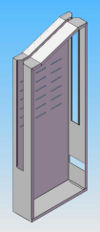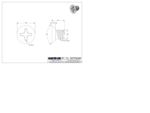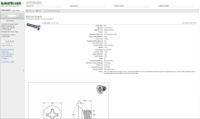Umbrella check-out system
From DDL Wiki
(→Table 1: Bill of Materials) |
(→Distribution and Placement) |
||
| Line 84: | Line 84: | ||
===Distribution and Placement=== | ===Distribution and Placement=== | ||
| - | + | Units should be placed at major doorways around the institution. While it is difficult to quantify what exactly a major doorway is, it should be fairly self-evident to people that frequent the facility. | |
| + | |||
| + | The umbrella dispenser's small footprint allows it to be placed almost anywhere in a hallway. Even a short row of dispensers does not occupy much floorspace. Dispensers can be placed at the sides of hallways, or, if the hallway is sufficiently wide, along the center to create a traffic divider. Units are battery powered and do not need to be located near a plug. | ||
| + | |||
| + | Dispensers that are not used often should be relocated to areas with higher than expected umbrella usage or traffic. The units will fit on any standard sized hand cart for easy transportation. As seen in our [Umbrella_final_report#Quantitative_Analysis:_Traffic_Study | analysis]], determining the distribution of units before placement is difficult. | ||
| + | |||
| + | For our sample implementation on the campus of Carnegie Mellon University, we estimate that approximately 160 dispensers will be needed. The doorways needing the most dispensers are those located in Doherty Hall, the University Center, and Porter Hall. | ||
| + | |||
===Failure Modes=== | ===Failure Modes=== | ||
FMEA table | FMEA table | ||
Revision as of 21:39, 5 December 2008
Final Wiki outline for ED2
Contents |
Executive Summary
Design
Objectives and Opportunities
Why we believe that this is a feasible idea, user study quotes
Physical Design
Component design, and how the unit operates.
Table 1: Bill of Materials
| Part Number | Name | Qty. | Function | Material | Manufacturing Process | Image | Engineering Drawing | Vendor Info |
|---|---|---|---|---|---|---|---|---|
| 1 | Dispenser Shell | 1 | Encloses unit | 18 Gauge Steel | Punching, Bending, Welding | 
| 
| Not Applicable |
| 2 | Short Support | 2 | Maintains rigidity of unit | Steel | Cold Rolling | 
| 
| Not Applicable |
| 3 | Long Support | 2 | Maintains rigidity of unit | Steel | Cold Rolling | 
| 
| Not Applicable |
| 4 | Drip Tray | 1 | Contains moisture from wet umbrellas | 18 Gauge Steel | Punching, Bending, Welding | 
| 
| Not Applicable |
| 5 | 6-32 x 3/16 Undercut Flat Head Machine Screw | 2 | Secures Drip Tray to Dispenser Shell | 18-8 Stainless Steel | Turning | Image:UmbrellaDispenserDripTrayScrew.jpg | 
| 
|
| 1 | Part 1 | 1 | does stuff | Steel | Stamping | Image:Imagename.jpg | Image:Imagename.jpg | Image:Imagename.jpg |
Distribution and Placement
Units should be placed at major doorways around the institution. While it is difficult to quantify what exactly a major doorway is, it should be fairly self-evident to people that frequent the facility.
The umbrella dispenser's small footprint allows it to be placed almost anywhere in a hallway. Even a short row of dispensers does not occupy much floorspace. Dispensers can be placed at the sides of hallways, or, if the hallway is sufficiently wide, along the center to create a traffic divider. Units are battery powered and do not need to be located near a plug.
Dispensers that are not used often should be relocated to areas with higher than expected umbrella usage or traffic. The units will fit on any standard sized hand cart for easy transportation. As seen in our [Umbrella_final_report#Quantitative_Analysis:_Traffic_Study | analysis]], determining the distribution of units before placement is difficult.
For our sample implementation on the campus of Carnegie Mellon University, we estimate that approximately 160 dispensers will be needed. The doorways needing the most dispensers are those located in Doherty Hall, the University Center, and Porter Hall.
Failure Modes
FMEA table
Manufacturing and Production
Process
Talk about manufacturing process here. Be sure to highlight DFMA considerations.
Volume
From our analysis, we estimate that we would need the capacity to store approximately 2000 umbrellas around Carnegie Mellon's campus. Given that our dispenser stores about 12 umbrellas per unit, we would need about 160 units for campus.
There are approximately 2500 four-year universities in the U.S., with an average enrollment of about 4400 students each. This is about half of Carnegie Mellon's undergraduate and graduate enrollment total. If the number of dispensers is directly related to the number of students, the average university will need 80 units.
If we can interest just 1% of four-year universities at the start, our estimated production volume will be 2000 units up front. Additional units or replacement parts may need to be purchased later. At an average lifespan of 5 years, an additional 400 units will need to be produced annually.
Prototype History
Discuss changes in our design through time.
First Prototype
Our initial prototype was designed to be a small modular unit with a simple design and low part count. The flat sides of the device allow multiple units to be placed next to each other for an umbrella distribution with multiple locations to take out and return umbrellas. The body of the device was built with wood material and painted red. The ramp on the top of the device, which was made of low-friction teflon material, moves umbrellas quickly from the receiving end to the dispensing end with no additional mechanical input from the system. Keeping the number of the device low allows the device to be reliable. The only places where the umbrellas need to be actively dealt with by the system are the input and output chutes. For the input chute, there was a latch attached to torsional spring to make sure that umbrellas cannot taken out from the receiving end once they are returned. Also, for the output chute, a turnstile was implemented to make sure that one umbrella is taken out at a time.

Second Prototype
Changes for our second prototype. -cardswipe activates electronic system -motor to power turnstile - will be replaced with worm drive to prevent backturning -also plan to add an encoder for better accuracy
-ventilation holes in side of box -ramp on inlet for umbrellas -removable drip tray -purchased umbrellas for use in system, cost: ~$3 each, lathed handles to fit unit
-evaluated barcode scanning -difficult and expensive to interface with microcontroller -now looking at RFID scanner from Parallax
-quantitative analysis -People counting, Markov model, computer vision tracking -big results: major entrances will need to carry ~2-300 umbrellas, gives us a ballpark of number of units necessary at those locations
Final Concept
Differences between our second and final prototypes.
Analysis
Comparison of Alternatives
QFD, etc can go here.
Quantitative Analysis: Traffic Study
Mechanical Analysis
Motivations
The physical construction of our device is relatively simple. It contains few components, and those components are already well-developed and commonly used. The size of the device is constrained by the umbrellas, and device weight is not a large concern since it will be stationary. Given this, we did not feel that a strictly mechanical analysis would provide us the insight that we need to develop a complete solution. In addition to the design of the hardware, the issue of implementing the system had to be addressed. This is where we chose to focus our analysis.
The largest issue of implementation is determining where to place the units, and how many modular units to put at each location. Traffic flow into and out of each doorway is the major determinant of this, so we decided to find out what the traffic flow was like as a function of time at the major doorways on campus. By determining the flow rate and difference in number of umbrellas at each location we can determine the number of umbrellas needed at each location for a given time, and the speed at which these umbrellas need to dry in order to be ready for reuse.
Methods
Two methods were used to investigate traffic flow at the major doorways. The first was to model our campus using a Markov simulation. This is model that uses probabilities of users moving from one location to another to estimate overall traffic flux around campus.
The second method was sitting by doorways and counting people going into and out of each doorway. Data was logged, time stamped, and analyzed later.
Findings
Our largest learning from these analyses is that it is very difficult to model traffic flow. Personally counting everyone moving through a given doorway is time-intensive. Modeling traffic flow is faster, but the number of assumptions necessary to produce a functional model may invalidate the results. Even if we could accurately model traffic flow on campus for a rainy day, the existence of the checkout system could alter traffic patterns significantly.
From observing people moving in and out of doorways, we got an order of magnitude estimation of necessary umbrella capacity at the major locations. Our analysis shows that it will take a capacity of approximately 200 to 300 umbrellas at the major doorways on campus.
The simplest solution to solve the modeling and estimation inaccuracies is to overpopulate the system initially, and then move units around as needed to meet demand. A full analysis to get a better estimate of traffic flow would be to difficult, if not impossible, to achieve, and would require many hours to realize. Overpopulation of units is simple and fast.
